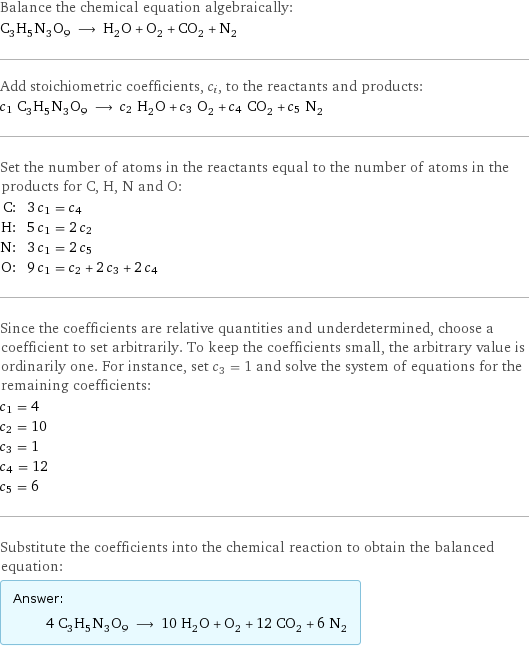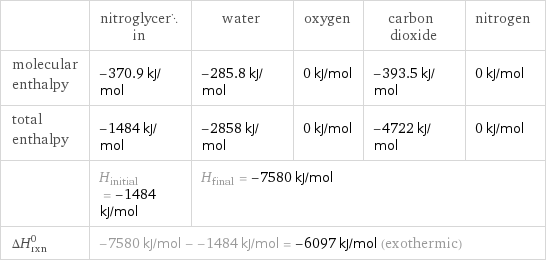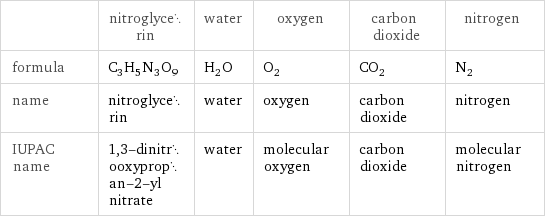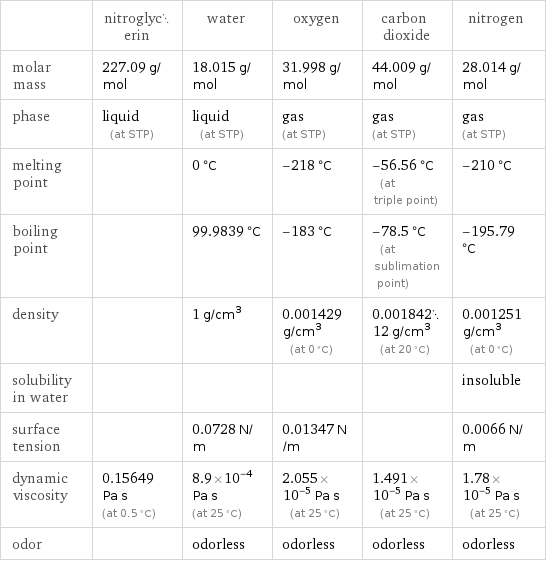Input interpretation

C_3H_5N_3O_9 nitroglycerin ⟶ H_2O water + O_2 oxygen + CO_2 carbon dioxide + N_2 nitrogen
Balanced equation

Balance the chemical equation algebraically: C_3H_5N_3O_9 ⟶ H_2O + O_2 + CO_2 + N_2 Add stoichiometric coefficients, c_i, to the reactants and products: c_1 C_3H_5N_3O_9 ⟶ c_2 H_2O + c_3 O_2 + c_4 CO_2 + c_5 N_2 Set the number of atoms in the reactants equal to the number of atoms in the products for C, H, N and O: C: | 3 c_1 = c_4 H: | 5 c_1 = 2 c_2 N: | 3 c_1 = 2 c_5 O: | 9 c_1 = c_2 + 2 c_3 + 2 c_4 Since the coefficients are relative quantities and underdetermined, choose a coefficient to set arbitrarily. To keep the coefficients small, the arbitrary value is ordinarily one. For instance, set c_3 = 1 and solve the system of equations for the remaining coefficients: c_1 = 4 c_2 = 10 c_3 = 1 c_4 = 12 c_5 = 6 Substitute the coefficients into the chemical reaction to obtain the balanced equation: Answer: | | 4 C_3H_5N_3O_9 ⟶ 10 H_2O + O_2 + 12 CO_2 + 6 N_2
Structures

⟶ + + +
Names

nitroglycerin ⟶ water + oxygen + carbon dioxide + nitrogen
Reaction thermodynamics
Enthalpy

| nitroglycerin | water | oxygen | carbon dioxide | nitrogen molecular enthalpy | -370.9 kJ/mol | -285.8 kJ/mol | 0 kJ/mol | -393.5 kJ/mol | 0 kJ/mol total enthalpy | -1484 kJ/mol | -2858 kJ/mol | 0 kJ/mol | -4722 kJ/mol | 0 kJ/mol | H_initial = -1484 kJ/mol | H_final = -7580 kJ/mol | | | ΔH_rxn^0 | -7580 kJ/mol - -1484 kJ/mol = -6097 kJ/mol (exothermic) | | | |
Equilibrium constant
![Construct the equilibrium constant, K, expression for: C_3H_5N_3O_9 ⟶ H_2O + O_2 + CO_2 + N_2 Plan: • Balance the chemical equation. • Determine the stoichiometric numbers. • Assemble the activity expression for each chemical species. • Use the activity expressions to build the equilibrium constant expression. Write the balanced chemical equation: 4 C_3H_5N_3O_9 ⟶ 10 H_2O + O_2 + 12 CO_2 + 6 N_2 Assign stoichiometric numbers, ν_i, using the stoichiometric coefficients, c_i, from the balanced chemical equation in the following manner: ν_i = -c_i for reactants and ν_i = c_i for products: chemical species | c_i | ν_i C_3H_5N_3O_9 | 4 | -4 H_2O | 10 | 10 O_2 | 1 | 1 CO_2 | 12 | 12 N_2 | 6 | 6 Assemble the activity expressions accounting for the state of matter and ν_i: chemical species | c_i | ν_i | activity expression C_3H_5N_3O_9 | 4 | -4 | ([C3H5N3O9])^(-4) H_2O | 10 | 10 | ([H2O])^10 O_2 | 1 | 1 | [O2] CO_2 | 12 | 12 | ([CO2])^12 N_2 | 6 | 6 | ([N2])^6 The equilibrium constant symbol in the concentration basis is: K_c Mulitply the activity expressions to arrive at the K_c expression: Answer: | | K_c = ([C3H5N3O9])^(-4) ([H2O])^10 [O2] ([CO2])^12 ([N2])^6 = (([H2O])^10 [O2] ([CO2])^12 ([N2])^6)/([C3H5N3O9])^4](../image_source/867bff16f3833ee143e6bf5b4427df97.png)
Construct the equilibrium constant, K, expression for: C_3H_5N_3O_9 ⟶ H_2O + O_2 + CO_2 + N_2 Plan: • Balance the chemical equation. • Determine the stoichiometric numbers. • Assemble the activity expression for each chemical species. • Use the activity expressions to build the equilibrium constant expression. Write the balanced chemical equation: 4 C_3H_5N_3O_9 ⟶ 10 H_2O + O_2 + 12 CO_2 + 6 N_2 Assign stoichiometric numbers, ν_i, using the stoichiometric coefficients, c_i, from the balanced chemical equation in the following manner: ν_i = -c_i for reactants and ν_i = c_i for products: chemical species | c_i | ν_i C_3H_5N_3O_9 | 4 | -4 H_2O | 10 | 10 O_2 | 1 | 1 CO_2 | 12 | 12 N_2 | 6 | 6 Assemble the activity expressions accounting for the state of matter and ν_i: chemical species | c_i | ν_i | activity expression C_3H_5N_3O_9 | 4 | -4 | ([C3H5N3O9])^(-4) H_2O | 10 | 10 | ([H2O])^10 O_2 | 1 | 1 | [O2] CO_2 | 12 | 12 | ([CO2])^12 N_2 | 6 | 6 | ([N2])^6 The equilibrium constant symbol in the concentration basis is: K_c Mulitply the activity expressions to arrive at the K_c expression: Answer: | | K_c = ([C3H5N3O9])^(-4) ([H2O])^10 [O2] ([CO2])^12 ([N2])^6 = (([H2O])^10 [O2] ([CO2])^12 ([N2])^6)/([C3H5N3O9])^4
Rate of reaction
![Construct the rate of reaction expression for: C_3H_5N_3O_9 ⟶ H_2O + O_2 + CO_2 + N_2 Plan: • Balance the chemical equation. • Determine the stoichiometric numbers. • Assemble the rate term for each chemical species. • Write the rate of reaction expression. Write the balanced chemical equation: 4 C_3H_5N_3O_9 ⟶ 10 H_2O + O_2 + 12 CO_2 + 6 N_2 Assign stoichiometric numbers, ν_i, using the stoichiometric coefficients, c_i, from the balanced chemical equation in the following manner: ν_i = -c_i for reactants and ν_i = c_i for products: chemical species | c_i | ν_i C_3H_5N_3O_9 | 4 | -4 H_2O | 10 | 10 O_2 | 1 | 1 CO_2 | 12 | 12 N_2 | 6 | 6 The rate term for each chemical species, B_i, is 1/ν_i(Δ[B_i])/(Δt) where [B_i] is the amount concentration and t is time: chemical species | c_i | ν_i | rate term C_3H_5N_3O_9 | 4 | -4 | -1/4 (Δ[C3H5N3O9])/(Δt) H_2O | 10 | 10 | 1/10 (Δ[H2O])/(Δt) O_2 | 1 | 1 | (Δ[O2])/(Δt) CO_2 | 12 | 12 | 1/12 (Δ[CO2])/(Δt) N_2 | 6 | 6 | 1/6 (Δ[N2])/(Δt) (for infinitesimal rate of change, replace Δ with d) Set the rate terms equal to each other to arrive at the rate expression: Answer: | | rate = -1/4 (Δ[C3H5N3O9])/(Δt) = 1/10 (Δ[H2O])/(Δt) = (Δ[O2])/(Δt) = 1/12 (Δ[CO2])/(Δt) = 1/6 (Δ[N2])/(Δt) (assuming constant volume and no accumulation of intermediates or side products)](../image_source/26eae9e65f15a951f817cabaede68a2d.png)
Construct the rate of reaction expression for: C_3H_5N_3O_9 ⟶ H_2O + O_2 + CO_2 + N_2 Plan: • Balance the chemical equation. • Determine the stoichiometric numbers. • Assemble the rate term for each chemical species. • Write the rate of reaction expression. Write the balanced chemical equation: 4 C_3H_5N_3O_9 ⟶ 10 H_2O + O_2 + 12 CO_2 + 6 N_2 Assign stoichiometric numbers, ν_i, using the stoichiometric coefficients, c_i, from the balanced chemical equation in the following manner: ν_i = -c_i for reactants and ν_i = c_i for products: chemical species | c_i | ν_i C_3H_5N_3O_9 | 4 | -4 H_2O | 10 | 10 O_2 | 1 | 1 CO_2 | 12 | 12 N_2 | 6 | 6 The rate term for each chemical species, B_i, is 1/ν_i(Δ[B_i])/(Δt) where [B_i] is the amount concentration and t is time: chemical species | c_i | ν_i | rate term C_3H_5N_3O_9 | 4 | -4 | -1/4 (Δ[C3H5N3O9])/(Δt) H_2O | 10 | 10 | 1/10 (Δ[H2O])/(Δt) O_2 | 1 | 1 | (Δ[O2])/(Δt) CO_2 | 12 | 12 | 1/12 (Δ[CO2])/(Δt) N_2 | 6 | 6 | 1/6 (Δ[N2])/(Δt) (for infinitesimal rate of change, replace Δ with d) Set the rate terms equal to each other to arrive at the rate expression: Answer: | | rate = -1/4 (Δ[C3H5N3O9])/(Δt) = 1/10 (Δ[H2O])/(Δt) = (Δ[O2])/(Δt) = 1/12 (Δ[CO2])/(Δt) = 1/6 (Δ[N2])/(Δt) (assuming constant volume and no accumulation of intermediates or side products)
Chemical names and formulas

| nitroglycerin | water | oxygen | carbon dioxide | nitrogen formula | C_3H_5N_3O_9 | H_2O | O_2 | CO_2 | N_2 name | nitroglycerin | water | oxygen | carbon dioxide | nitrogen IUPAC name | 1, 3-dinitrooxypropan-2-yl nitrate | water | molecular oxygen | carbon dioxide | molecular nitrogen
Substance properties

| nitroglycerin | water | oxygen | carbon dioxide | nitrogen molar mass | 227.09 g/mol | 18.015 g/mol | 31.998 g/mol | 44.009 g/mol | 28.014 g/mol phase | liquid (at STP) | liquid (at STP) | gas (at STP) | gas (at STP) | gas (at STP) melting point | | 0 °C | -218 °C | -56.56 °C (at triple point) | -210 °C boiling point | | 99.9839 °C | -183 °C | -78.5 °C (at sublimation point) | -195.79 °C density | | 1 g/cm^3 | 0.001429 g/cm^3 (at 0 °C) | 0.00184212 g/cm^3 (at 20 °C) | 0.001251 g/cm^3 (at 0 °C) solubility in water | | | | | insoluble surface tension | | 0.0728 N/m | 0.01347 N/m | | 0.0066 N/m dynamic viscosity | 0.15649 Pa s (at 0.5 °C) | 8.9×10^-4 Pa s (at 25 °C) | 2.055×10^-5 Pa s (at 25 °C) | 1.491×10^-5 Pa s (at 25 °C) | 1.78×10^-5 Pa s (at 25 °C) odor | | odorless | odorless | odorless | odorless
Units
